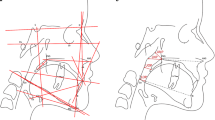Abstract
Stating background
The clival angle, between the ethmoidal plane and the clival plane, measures the cranial base angulation. Relations between cranial base angulation and facial patterns have been discussed and present contradictory evidence. The aim of this study is to determine whether correlations could be found between the clival angle and craniofacial measurements.
Methods
This study was carried out on a sample of 235 human skulls. Twenty landmarks were marked. The clival angle and 16 other variables were measured and compared using analysis of variance.
Results
Statistical analysis showed a relationship between the clival angle and six measurements (P < 0.05). There was a positive correlation between the clival angle and the cranial lengths, the nasomaxillary sagittal measurements and palatal length but the width of the foramen magnum had a negative correlation. No significant relationship was found between the clival angle and the cranial height and widths, the palatal width, the length of the foramen magnum and the mandibular measurements.
Conclusions
The trends found in this study with regard to the craniofacial lengths show that the nasomaxillary complex in humans has a stable position lying beneath the anterior cranial base. Transversal, vertical and mandibular variables have a more independent relationship.


Similar content being viewed by others
References
Anderson DL, Popovich F (1983) Relation of cranial base flexure to cranial form and mandibular position. Am J Phys Anthropol 61:181–187
Björk A (1955) Cranial base development. Am J Orthod 41:198–225
Coben SE (1961) Growth concepts. Angle Orthod 31:194–201
Delaire J, Schendel SA, Tulasne JF (1981) An architectural and structural craniofacial analysis: a new lateral cephalometric analysis. Oral Surg Oral Med Oral Path 52:226–238
Delaire J, Salagnac J M, Notari F (1994) Diagnostic des dysmorphoses dento-maxillo-faciales. Apport de l’analyse architecturale informatisée. Acta Odontol Stomatol 187:477–511
Dibbets JMH (1992) Morphological association between the Angle classifications. Eur J Orthod 18:111–118
Enlow DH, McNamara JA (1973) The neurocranial basis for facial form and pattern. Angle Orthod 43:256–270
Enlow DH (1982) Handbook of facial growth, 2nd edn. WB Saunders, Toronto
George SL (1978) A longitudinal and cross-sectional analysis of the growth of the postnatal cranial base angle. Am J Phys Anthropol 49:171–178
Kasai K, Moro T, Kanazawa E, Iwasawa T (1995) Relationship between cranial base and maxillofacial morphology. Eur J Orthod 17:403–410
Kerr WJ, Hirst D (1987) Craniofacial characteristics of subjects with normal and postnormal occlusions–a longitudinal study. Am J Orthod Dentofac Orthop 92:207–212
Kuroe K, Rosas A, Molleson T (2004) Variation in the cranial base orientation and facial skeleton in dry skulls sampled from three major populations. Eur J Orthod 26:201–207
Landzert T (1866) Der sattelwinkel und sein verhaeltnis zur pro und orthognathie. Abh Senckenb Naturforsch Gesicht 6:19–165
Leonetti G, Signoli M, Hershkovitz I, Latimer B, Terve JP, Jellema L, Cianfarani F, Dutour O (1997) Variation de l’angle sphénoïdal du crâne humain en fonction du vieillissement. C R Acad Sci III 320:943–947
Lieberman DE, McCarthy RC (1999) The ontogeny of cranial base angulation in humans and chimpanzees and its implications for reconstructing pharyngeal dimensions. J Hum Evol 36:487–517
Oyar O, Govsa F, Sener RN, Kayalioglu G (1996) Assessment of normal clivus related to age with magnetic resonance imaging. Surg Radiol Anat 18:47–49
Ross CF, Ravosa MJ (1993) Basicranial flexion, relative brain size, and facial kyphosis in nonhuman primates. Am J Phys Anthropol 91:305–324
Ross C, Henneberg M (1995) Basicranial flexion, relative brain size, and facial kyphosis in Homo sapiens and some fossil hominids. Am J Phys Anthropol 98:575–593
White TD (2000) Human osteology, 2nd edn. Academic, San Diego
Author information
Authors and Affiliations
Corresponding author
Rights and permissions
About this article
Cite this article
Guyot, L., Richard, O., Adalian, P. et al. An anthropometric study of relationships between the clival angle and craniofacial measurements in adult human skulls. Surg Radiol Anat 28, 559–563 (2006). https://doi.org/10.1007/s00276-006-0161-5
Received:
Accepted:
Published:
Issue Date:
DOI: https://doi.org/10.1007/s00276-006-0161-5




